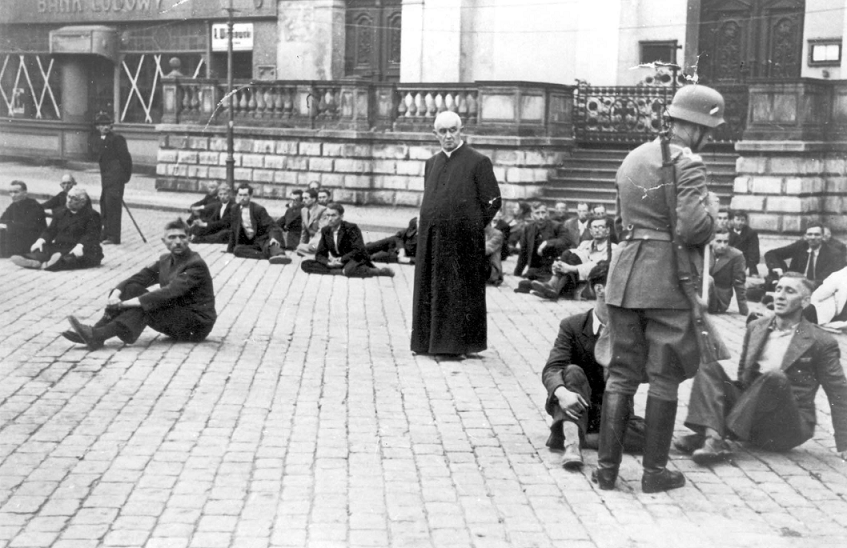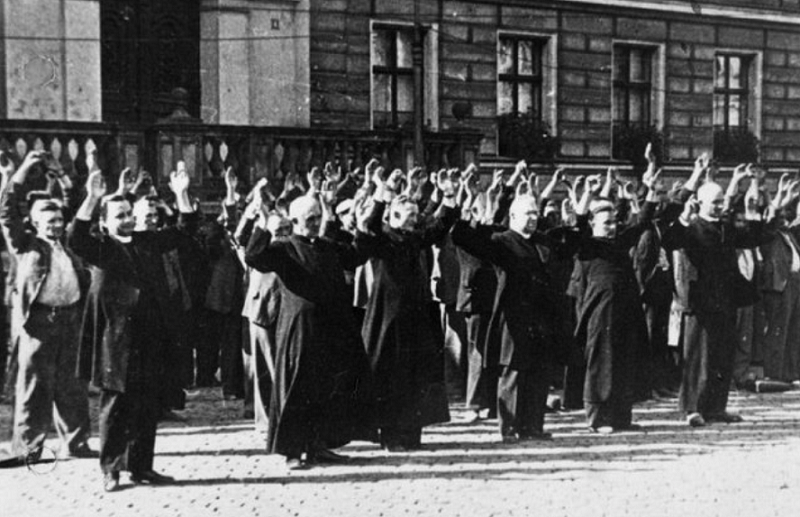Tribute to the Victims of Totalitarianism – The Church in Poland Celebrates the Martyrdom of the Polish Clergy


Polish priests and civilians as German hostages in Bydgoszcz (September 1939), public domain
On the initiative of the Polish Bishops’ Conference, the Day of the Martyrdom of the Polish Clergy is celebrated on April 29th. It is the commemoration of thousands of priests, deacons, and men and women religious who were the victims of Nazi and communist totalitarianism. The date refers to the anniversary of the liberation of the German concentration camp KL Dachau by the American troops in 1945.
This was the main extermination camp where members of the Polish clergy were executed during World War II. In this place, the Germans murdered 868 clergymen from our country, of the 1773 Polish priests and bishops imprisoned there. In all, nearly 3,000 members of the Catholic clergy from various countries were imprisoned in Dachau. Considering the entire World War II period, every fifth diocesan priest in Poland was murdered (about 2,000 out of 10,000). In addition, more than 600 men and women religious died. Some dioceses suffered the loss of 70-80 percent of their pre-war clergy.
“In Dachau, the number of Polish priests murdered there exceeded all other victims from the clergy of other European countries,” said Prof. Jan Żaryn, director of the Institute for the Heritage of National Thought. He pointed out that the martyrdom of the Polish priests related to their Polishness, which they guarded, and Christian faith, which was in opposition to the pagan character of Nazism.
Prof. Jan Żaryn emphasized that among the victims of Dachau there were both young priests and clergy distinguished in the pastoral ministry of the Second Polish Republic. “Blessed Father Stefan Frelichowski, a priest who today is the patron of scouts, was among them. He was this symbol of Polish patriotism, of young priests following in the footsteps of such figures like Fr. Ignacy Skorupka. Among the priests murdered in Dachau, there was also Blessed Father Edward Detkens who was connected with the academic ministry in Warsaw,” recalled the historian.
Priests imprisoned in Dachau made a vow that, if they survived the camp, they would make a pilgrimage to the Sanctuary of St. Joseph in Kalisz. On 29 April 1945, a few hours before the Germans planned to murder the prisoners and destroy the camp, the Americans entered Dachau, liberating 33,000 people, including 856 priests.

Polish priests and civilians as German hostages in Bydgoszcz (September 1939), public domain
According to the decision of the Polish Bishops’ Conference, the main place of commemoration of the Day of Martyrdom of the Polish Clergy is the Sanctuary of St. Joseph in Kalisz. The celebrations there are a continuation of the thanksgiving pilgrimages of priests rescued from the Dachau Concentration Camp.
“Moreover, this year, in the Sanctuary of St. Joseph in Kalisz, we will offer a prayer of thanksgiving for our brothers in the priesthood who suffered death and bore witness to their fidelity to Christ in so many places of extermination and suffering during the last world war. On 29 April 2021 at noon, Bishop Grzegorz Suchodolski of Siedlce, Poland, will preside over The Mass in the National Shrine of St. Joseph in Kalisz and give the homily,” says Msgr. Damian Bryl, Ordinary of the Diocese of Kalisz, in a letter. Due to the pandemic, the bishop encourages the clergy from all over Poland to join in the prayer which will be transmitted via the internet.
Prof. Jan Żaryn also drew attention to the heroic attitude of consecrated persons during World War II. The main example is the Franciscan St. Maximilian Maria Kolbe who, in Auschwitz, offered his life for a fellow prisoner, Franciszek Gajowniczek. “An important role in rescuing Jews was also played by men and women religious, especially after 1942, when Jews aware of the ongoing Holocaust began escaping from the ghettos to the so-called ‘Aryan side’,” recalled the historian.
Many clergy members who were victims of World War II were also military chaplains. One of the 108 blessed Polish martyrs beatified by Pope John Paul II in Warsaw in 1999 was the Dominican Father Michał Czartoryski who, during the Warsaw Uprising, was shot by the Germans in a hospital with seriously wounded people.
“If the beatification of 108 clerical and lay martyrs makes us rejoice today, this is above all because they are a testimony of Christ’s victory – a gift that restores hope,” said John Paul II in Warsaw on 13 June 1999.
The Day of Martyrdom of the Polish Clergy is also a day of remembrance of hundreds of priests, victims of totalitarian communism. The symbol of the martyrdom of Polish priests during the communist period is Blessed Father Jerzy Popiełuszko, murdered by functionaries of the Security Service in October 1984.
Prof. Jan Żaryn recalled that the Polish clergy also underwent Soviet repression. An example is the story of Blessed Father Władysław Bukowiński, pastor of the cathedral in Lutsk, who was sent as a prisoner to the Soviet Gulag camps, exiled to Kazakhstan, where he carried out pastoral and missionary work until he died in 1974.
Prof. Jan Żaryn emphasized that, during the Stalinist period, approximately one thousand priests passed through Communist prisons, that is, 10 percent of the Polish clergy at that time. “These are people who were chaplains of the Home Army, and later active Catholic social workers. I have in mind Father Tomasz Rostworowski or Father Zygmunt Kaczynski (…) murdered most probably in prison in May 1953,” said the director of the Institute for the Heritage of National Thought. The historian also drew attention to the imprisonment or internment of the most important figures of the Church in Poland, led by Cardinal Stefan Wyszynski. “The martyrdom that accompanied the Polish priesthood corresponded to the degree of the totalitarian state, the use totalitarian tools. However, as we know, until the end of the People’s Republic of Poland, this ‘ability’ of the communists to use the most anti-church tools was manifested,” noted Prof. Jan Żaryn.
The historian recalled the still unexplained assassination of three priests in 1989: Father Stefan Niedzielak, Father Stanislaw Suchowolc, and Father Sylwester Zych.



Dodaj komentarz